
The tamaraw or Mindoro dwarf buffalo is a small hoofed mammal belonging to the family Bovidae. It is endemic to the island of Mindoro in the Philippines, and is the only endemic Philippine bovine. It is believed, however, to have once also thrived on the larger island of Luzon. The tamaraw was originally found all over Mindoro, from sea level up to the mountains, but because of human habitation, hunting, and logging, it is now restricted to only a few remote grassy plains and is now a critically endangered species.
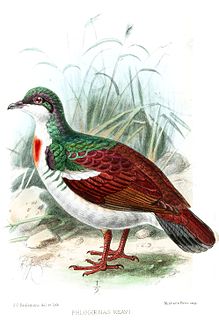
The Negros bleeding-heart pigeon is endemic to the Philippines where it is found on the islands of Negros and Panay. It is critically endangered; continuing rates of forest loss on the two islands where it occurs suggest that it will continue to decline. The species has an extremely small, severely fragmented population. The bird is listed as an EDGE species under the analysis of the Zoological Society of London.

The São Tomé shrew is a white-toothed shrew about 3.0 in (7.6 cm) long found only on São Tomé Island, São Tomé and Príncipe. It is listed as a critically endangered species due to habitat loss and a restricted range. It was discovered in 1886. The population continues to decrease, making these animals rare. It is found only on São Tomé Island, a small island that is actually a shield volcano that rises out of the Atlantic Ocean.
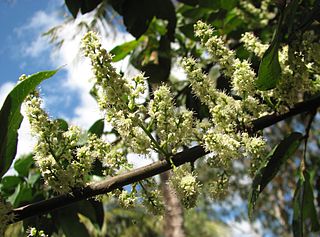
Guioa is a genus of about 78 rainforest tree species known to science, which constitute part of the plant family Sapindaceae. They have a wide distribution, ranging from throughout Malesia, in Burma, Cambodia, Vietnam, Thailand, Malay Peninsula, Borneo, Sumatra, Philippines, Java, Flores, Timor, Sulawesi, Moluccas, New Guinea, further southwards through the east coast of Queensland and New South Wales, Australia and further eastwards to the Pacific Islands, including Tonga, New Caledonia, Fiji and Samoa.

The Philippine warty pig is one of four known species in the pig genus (Sus) endemic to the Philippines. The other three endemic species are the Visayan warty pig, Mindoro warty pig and the Palawan bearded pig, also being rare members of the family Suidae. Philippine warty pigs have two pairs of warts, with a tuft of hair extending outwards from the warts closest to the jaw. It has multiple native common names, but it is most widely known as baboy damo in Tagalog.

Vanda javierae is a species of flowering plant in the orchid family, Orchidaceae. It is endemic to the Philippines, where it occurs on Luzon and Calayan Island. It is known commonly as Mrs. Javier's vanda.
Platymantis lawtoni is an endangered species of frog in the family Ceratobatrachidae. It is endemic to Romblon, Philippines. It occurs in the rainforests of Romblon, Tablas, and Sibuyan Islands.

The giant scops owl, lesser eagle-owl or the Mindanao eagle-owl, is a species of owl in the family Strigidae. It is endemic to the Philippines. In size and structure, it is considered intermediate between a scops owl and an eagle-owl. Its natural habitat is subtropical or tropical moist lowland forests. It is threatened by habitat loss.
The Tawitawi brown dove is a threatened species of bird in the family Columbidae. It is endemic to forests in the Sulu Archipelago in the Philippines. Until recently it was considered conspecific with the Mindanao brown dove and collectively called the dark-eared brown dove. Although threatened by habitat loss, the rate of loss significantly reduced from 2004–2007, and it was thus downlisted from Critically Endangered to Endangered status in the 2007 IUCN Red List.

The common cactus finch or small cactus finch is a species of bird in the Darwin's finch group of the tanager family Thraupidae. It is endemic to the Galapagos Islands, where it is found on most islands, with the notable exception of Fernandina, Española, Genovesa, Darwin and Wolf. Most of these islands are inhabited by its close relative, the Española cactus finch.

The Tinian monarch is a species of bird in the family Monarchidae. It is endemic to the Northern Mariana Islands.
The eared hutia or large-eared hutia is a species of rodent in the family Capromyidae. It is endemic to the island of Cayo Fragoso off the northern coast of Cuba.

The Hainan gymnure or Hainan moonrat is a species of mammal in the family Erinaceidae. Its natural habitat is subtropical or tropical dry forests. It was thought to be endemic to the island of Hainan, China where it is threatened due to habitat loss, but in 2018 was found to also occur in, and be rather common, within Northern Vietnam.
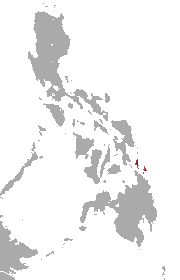
The Dinagat gymnure is a species of mammal in the family Erinaceidae. It is endemic to the Philippines.
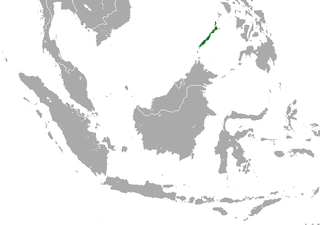
The Palawan shrew is a species of mammal in the family Soricidae. It is endemic to the Philippines and known from Palawan and Balabac Islands, from sea level to 1,300 m (4,300 ft) asl. It occurs in old growth and scrubby secondary forest. Habitat loss (deforestation) is a potential threat to this little known species, although it seems to tolerate habitat loss and modification.
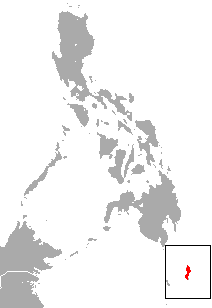
The Talaud flying fox or Talaud fruit bat is a species of bat in the family Pteropodidae. It is endemic to the islands of Salebabu and Karekaleng in the Talaud Archipelago of Indonesia. Its natural habitat is subtropical or tropical swamps.

The small-toothed fruit bat is a species of megabat in the family Pteropodidae. It is monotypic within the genus Neopteryx.

The Philippine tube-nosed fruit bat locally known in Tagalog as Bayakan is a species of bat in the family Pteropodidae. It is endemic to the Philippines and known from the islands of Cebu, Negros and Sibuyan. It occurs in and near primary and secondary subtropical or tropical dry forests. It is often found near water. It is threatened by habitat loss due to deforestation. The species is named for Dioscoro S. Rabor who, with several others, first collected the species.
Vatica elliptica is a rare species of tree in the family Dipterocarpaceae, native to Mindanao island in the Philippines.
Vatica pachyphylla is a species of flowering plant in the family Dipterocarpaceae.
















